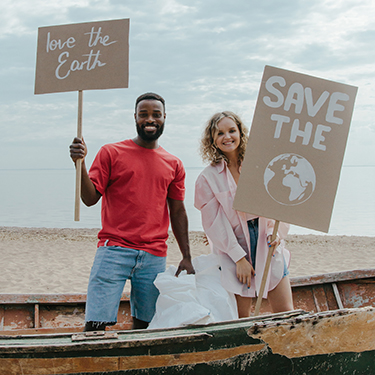This year’s celebration of Earth Day, to be marked April 22, is focused on climate and environmental literacy. Youth play an important role in education and action on climate change, according to Evelyn Maldonado, program associate for APHA’s Center for Climate, Health and Equity. In this guest post, she speaks with Evelyn Bigini, MSc, RN, a child care health consultant at the University of California-San Francisco who serves on Earth Uprising’s Global Youth Leadership Council, and Natasha Matta, a University of Michigan student who is co-founder of the Environmental Justice Coalition.
Maldonado: We’re celebrating Earth Day by bringing awareness to climate education and the role young people can and are playing to advocate for climate justice.
Why is climate education important for youth?
Matta: Climate education is essential because it equips youth with the skills and knowledge to navigate the changing world around them. It’s important to understand how and why climate change occurs and how issues such as global warming can affect you. 
Climate education can help youth make informed decisions, reduce their carbon footprint and combat climate change. Today’s youth will be our next generation of climate scientists, policymakers, activists, etc., and climate education is the foundation for working toward environmental protection and a more equitable future.
Maldonado: Absolutely! However, most high schools don’t provide education about climate change and its health impacts. Recently, a new Climate and Health Youth Education Toolkit, created by APHA’s Environment Section and APHA’s Center for Climate, Health and Equity, was launched. It’s based on a lesson plan from the National Institute of Environmental Health Sciences. The toolkit provides supporting materials and a lesson plan for guest lecturers to educate and engage youth on climate and health.
Natasha, I know you were involved with the lesson plan. How were youth perspectives integrated into it?
Matta: To integrate a youth perspective, the team at APHA asked me and Rhea Goswami, who also works in the environmental justice space, to review and edit the lesson plan to ensure it was accessible and interesting to students like ourselves.
Additionally, we added an extension — an optional add-on to the lesson plan teachers can use — connecting climate and health to environmental justice. It includes the history of the environmental justice movement, statistics on environmental racism and examples of affected cities across the U.S.
Maldonado: That’s wonderful! Young people have a powerful voice to advocate for climate action and it’s important to give youth the opportunity to use it.
Matta: Definitely! Giving youth a seat at the table empowers us and shows that we are capable of making change in the environmental and climate space. Climate change affects us all, so we need diverse perspectives represented in decisionmaking, including different generational perspectives.
Resources meant for youth should be co-developed and reviewed by (youth), as the lesson plan was, to make sure they meet our needs and interests and will be as effective as possible.
Maldonado: Thanks, Natasha. Glad the lesson plan and toolkit can continue to be used as youth-co-developed, adaptable resources.
Evelyn, beyond these resources, what are some other ways youth can be engaged in climate education?
Bigini: It can be helpful to reach out to and collaborate with organizations and working groups also interested in this topic. This collaboration is important for climate education, as it’s such a broad and important field: Climate education spans from the preschool to university levels. For example, youth interested in early childhood education can advocate for environmental education in preschool curricula.
At the UCSF California Childcare Health Program, we’re trying to increase awareness about environmental health interventions surrounding pesticide exposures in early care and education and child care programs.
Maldonado: Wow! That sounds interesting.
What about youth who are interested in incorporating climate education into their post-high school studies?
Bigini: Great question! I’m a nurse, so I mainly know about climate education in the health sciences fields. Organizations like the Alliance of Nurses for Healthy Environments and Climate Resources for Health Education provide great resources. The alliance has wonderful publications and curriculum recommendations. The resources group provides free, evidence-based presentations and case studies to incorporate climate change and planetary health concepts into health education curricula. In addition to medical and advanced practice provider curricula, they have expanded to nursing, pharmacy and health equity education. I’d suggest doing some online searches to find groups working on the topics youth are interested in!
Maldonado: Thanks for these resources, Evelyn.
You also just mentioned health equity. Can you expand on how that concept relates to climate and health education?
Bigini: To promote health equity, we have to focus on the social determinants of health: where we live, work and play. As Natasha mentioned, we have to address social and environmental injustices. These are big challenges, so I think we should focus on working with people outside of our current fields.
For example, if someone knows about climate and health intersections, they can work with people interested in the humanities, maybe someone who wants to use art to spread awareness. Joining advocacy organizations like Earth Uprising International can be a good place to start.
Maldonado: Great advice! There are certainly many ways we can get involved and help educate and engage our youth. And ways for other youth to get involved as well. Here are some resources to get you started:
- Check out the Climate and Health Youth Education Toolkit and give a guest lecture on climate, health and equity at local high schools, summer camps or anywhere that students in grades 9-12 learn. If you fill out this form, we will follow up with further information and support.
- Learn more about advocating for climate justice with advice from and for youth climate leaders.
- Learn about what other students are doing to raise awareness and engage their campuses on climate justice.
Photo by Ron Lach, courtesy Pexels